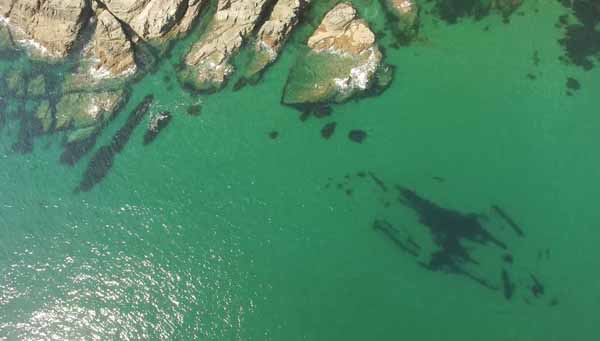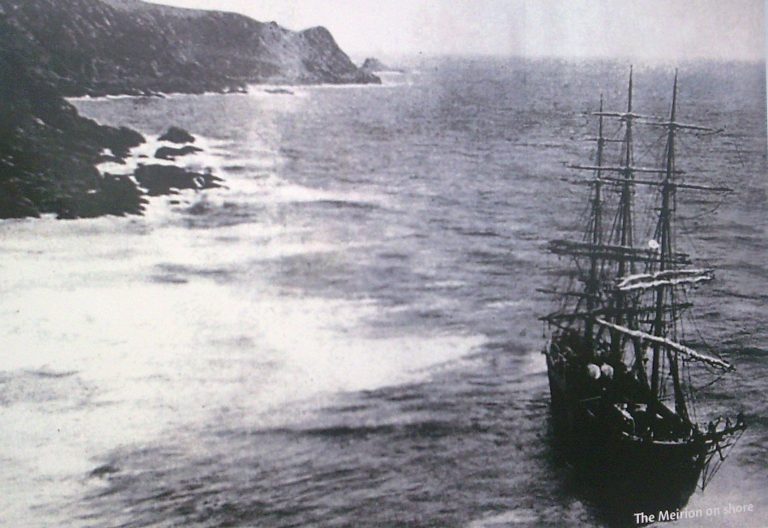Meirion 1879
N50.13.074 E3 45.156

View of the Meirion from a drone

The “Meirion” was an iron sailing ship, belonging to the Port of Liverpool, of 1,372 tons net register. She was built at Sunderland in the year 1878, and at the time of her loss was the property of the Arvon Shipping Company, Limited. In June 1878 she left Sunderland bound with a cargo of coals to Bombay, and having there discharged her coals she proceeded to Rangoon, where she shipped a cargo consisting of about 2,050 tons of rice and cutch, with which she left on the 15th of March last for London direct. She had at this time a crew of 23 hands all told, and was in every respect in good order and condition, save that her compasses were we are told out of order, and that her bottom was very foul. Off the Cape of Good Hope she encountered a very severe storm, which threw her upon her beam ends, washing one of the hands overboard. Another of the hands subsequently died of heart disease, so that on nearing the Channel she had only 21 hands on board.
The following was reported to the Board Of Enquiry:
“At about 10 p.m. of the 5th of September the Wolf Rock was sighted, bearing N.N.E., distant about 12 miles, and as the wind was at that time from the east she was laid with her head to the southward. Shortly after midnight the wind came away from the west, upon which the vessel was laid upon an E. 1/2 N. course, and that course was continued until noon of the 6th, when it was altered to E. 1/2 S., and at 4 p.m. it was again changed to S.E. by E. 1/2 E. At about 9 p.m. a light was seen, but the master appears at first to have been in some doubt as to what it was; at 10, however, he tells us that he made it out to be the Eddystone, and that it then bore N.N.E., distant from 10 to 12 miles, upon which the course was altered to S.E., the wind at the time blowing a moderate breeze from the S.W. They had to starboard to avoid a passing steamer, but we are told that the S.E. course was immediately afterwards resumed, and that that course was continued until about 1 or half-past 1, when the master says that he observed what appeared to be either the loom of the land or a fog bank, both ahead and on the port beam, upon which orders were given to brace the yards sharp up, but at that time the wind had got rather more to the southward. Finding that she was getting too close to the land, and knowing that she would not stay, the master after a time ordered all hands to be called up to wear ship. The helm was then put hard up, and the yards squared, and when her head had come round to about north she struck, the weather at the time being so thick that they could not see the land, although it was close to them. The place where she struck was on Rickham Sand, inside of and about three-quarters of a mile to the N.W. of Prawl Point, and in the upper part of Salcombe Bay. It was now about 2 o’clock, and the tide was about three-quarters ebb. All the sails were thereupon taken in except the lower topsails, and the after yards were braced up on the port tack, and according to the mate the spanker was set. Nothing else, however, seems to have been done to get the vessel off, and at about 4 a.m., on its becoming light, the master left for Salcombe with four of the hands, with the view of obtaining the assistance of a tug boat. On arriving there he communicated with Lloyd’s agent, and by his advice telegraphed to Plymouth for a tug. Owing, however, to its being Sunday a good deal of time elapsed before any arrangements could be made. In the meantime the wind had begun to blow, and about 10 o’clock, the coastguard having come down to the ship, and thrown a rocket over the vessel, a communication was established with the ship, and the remainder of the crew then left her and went ashore. Between 3 and 4 o’clock p.m. the steam tug arrived from Plymouth, but it was then blowing too hard to go near her, and nothing could therefore be done. The following day some of the men’s clothes were saved, but the vessel herself became a total wreck, and has been lost together with the whole of her valuable cargo. The value of the vessel and cargo was, about £40,000.
At the board of enquiry held in Plymouth, the following was the finding of the the Wreck Commissioner H.C. Rothsey
“It being, therefore, in our opinion quite clear that the vessel was not navigated with proper and seamanlike care, it remains for us to say who is responsible for this casualty, and whether we are to accede to Mr. Wolferstan’s application, that the certificates of the master and of the first mate should be dealt with. Now although the chief mate had the watch when the vessel went ashore it seems that the master was at the time on deck, and that everything that was done was done by his orders and under his directions. If then anyone was to blame for this casualty it was the master and the master alone. The mate’s certificate was therefore returned to him. But as regards the master, seeing the little care which he seems to have taken of his compasses; his neglect to take a cast of the lead, or to put his ship about when he saw something which he admits may have been land to leeward, and this, too, when the weather was so thick that he could not see the land until he was very near it; considering also that he took no steps to get the vessel off after she had grounded, and instead of dropping his bower anchor, kept the lower topsails standing and set the spanker; and that instead of remaining by his vessel, as he should have done, he left her for the purpose of seeking assistance whilst she was in a state of imminent danger. Taking all these circumstances into consideration, we were of opinion that his certificate should be suspended for six months; but on the application of his advocate, Mr. Edmonds, we agreed to recommend to the Board of Trade that during the suspension of his master’s certificate he should be allowed a first mate’s certificate.”